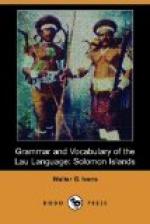LAU GRAMMAR.
THE ALPHABET.
The vowels are a, e, i, o, u, with the Italian sounds. All of these vowels may be long or short, the long sound being represented by a doubling of the vowel. Closed syllables do not occur, and every word ends with a vowel. The vowel o in Lau frequently represents a in Sa’a: fou rock, Sa’a hau; finau hook, Sa’a hinou; loulou quick, Sa’a lauleu. Where in Sa’a a changes to e in certain words after a preceding i or u, no such change is made in Lau in the same words: ia fish, Sa’a i’e; ua still, Sa’a ue; i asi at sea, Sa’a i ’esi.
The diphthongs are ae, ai, ao, eu, ei, ou, as in sae, mai, rao, dau, mei, fou, pronounced, respectively, as in the English words eye, iron, hour, how, hey, oh.
The consonants are f, k, g; d, t; b; q, gw; l, r; s; m; mw; n, ng.
The f replaces an h in Sa’a: fera village, Sa’a hera courtyard; fuli fera village, Sa’a huli bed, huli nume site of house. The sound represented by f often approximates to v.
Both k and g are hard. The Melanesian g is not heard; as in Sa’a, it has been dropped in certain words, ia fish, but there is no noticeable break in the pronunciation. In certain other words this g is replaced by k: take, to stand. Mota sage, Sa’a ta’e. The g in Lau may replace a k in Sa’a: igera they, Sa’a ikire. A g also appears in personal pronoun plural 1, excl., where Sa’a has a break: igami we, Sa’a i’emi. A g may also replace an h in Sa’a: luga to loose, Sa’a luhe.
There is no preface of n in the sound of d.
In many words a t has been dropped: angi to cry, Oceanic tangi; asi sea, Oceanic tasi; ola canoe, Florida tiola, Sa’a ’iola.
There is no w in Lau. Where it occurs in Sa’a its place is supplied in Lau by q, the sound of which is kw or ku: qalu eight, Sa’a walu. In Lau the island Ulawa is known as Ulaqa. A q in Lau may represent an h in Sa’a: qai, the reciprocal prefix, is in Sa’a hai. The letter gw may represent a q (pw) in Sa’a: gwou head, Sa’a qau; gwini wet, Sa’a qini; gwou deserted, Mota wou. The sound of d is not followed by r, as is the case in Sa’a, nor is d before i sounded any way differently, as is the case in Sa’a. Nasal m, i.e., mw, is not so common a sound as it is in Sa’a, but it is heard in mwane male, mwela child.
There is an interchange between n and l: nima or lima five; daluma middle, Sa’a danume; inala to discern, Sa’a ilala. Both l and r are used and the sounds are distinct; both sounds are trilled.




